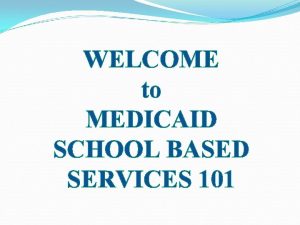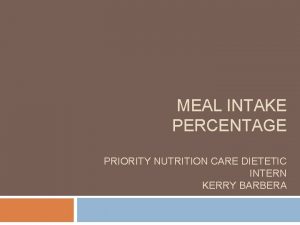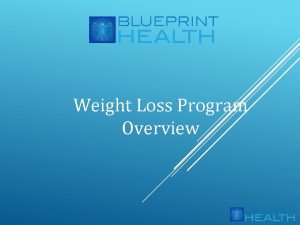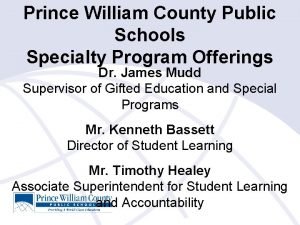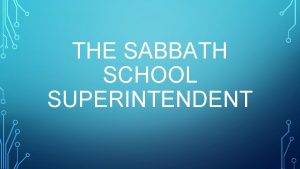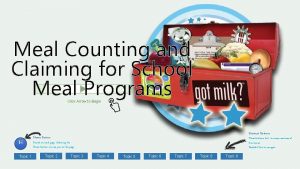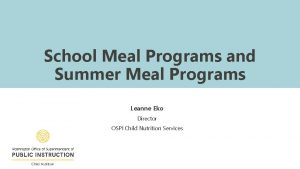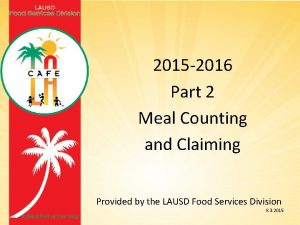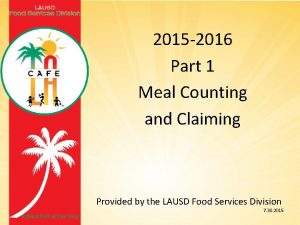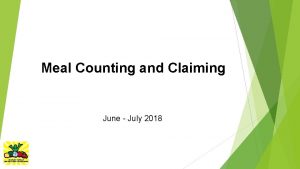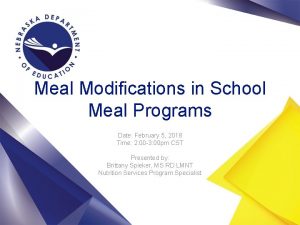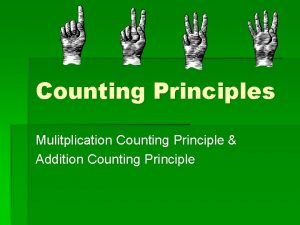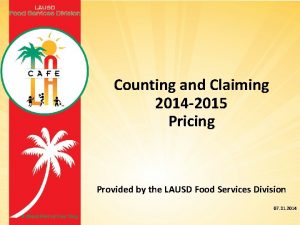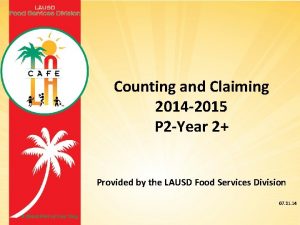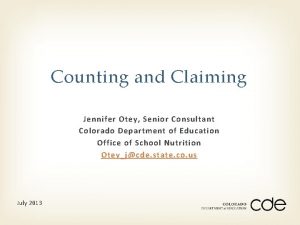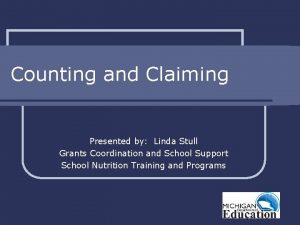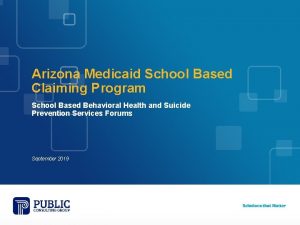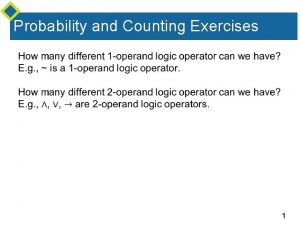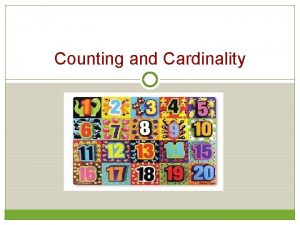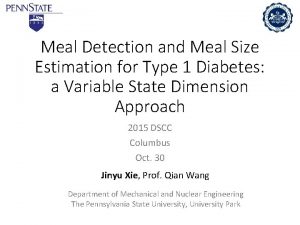Meal Counting and Claiming for School Meal Programs





















- Slides: 21

Meal Counting and Claiming for School Meal Programs Click Arrow to Begin H Topic 1 Shortcut Buttons Home Button These buttons link to major sections of this course. Double-Click to navigate. Found on each page. Selecting the Home button returns you to this page. Topic 2 Topic 3 Topic 4 Topic 5 Topic 6 Topic 7 Topic 8 Topic 9

Meal Counting and Claiming for School Meal Programs School Nutrition Toolbox NAVIGATION Navigation is pretty basic. Back Button, Forward Button, and Home Button. Back Button Found on each page. Selecting the Back button returns you to the previous page. Forward Button Found on each page. Selecting the Forward button advances you to the next page. Home Button Found on each page. Selecting the Home button returns you to the very beginning page. 2 H

Participants will: 1. List the elements of an acceptable meal counting and claiming system. BACKGROUND School Nutrition Toolbox Meal Counting and Put Claiming Course Name for School Here Meal Programs T OPIC 1 | M EAL C OUNTING AND C LAIMING S YSTEM Federal and state reimbursement is provided for each school meal that meets program requirements and is served to an eligible student. School personnel must accurately count, record, and claim the number of meals served to students by eligibility category (i. e. free, reduced price and paid). Adequate documentation must be on file to support the claims for free and reduced price meals. All meal counting and claiming systems must provide an accurate count at the point of service. Point of service is the point in the serving line where it can be determined that a reimbursable meal meeting the menu planning option requirements is being served. Reimbursable meals must be counted by category of eligibility for each day without overt identification. Continued on next slide. 3 H

BACKGROUND (CONTINUED) Elements of an acceptable meal counting and claiming system include: 1. 2. 3. 4. 5. 6. Eligibility Documentation Collection Procedures Point of Service Meal Counts Reports Claims for Reimbursement Internal Controls School Nutrition Toolbox Meal Counting and Put Claiming Course Name for School Here Meal Programs T OPIC 1 | M EAL C OUNTING AND C LAIMING S YSTEM 4 H

Participants will: 1. Describe the eligibility documentation requirements related to meal counting and claiming. APPLICATION School Nutrition Toolbox Meal Counting and Put Claiming Course Name for School Here Meal Programs T OPIC 2 | E LIGIBILITY D OCUMENTATION R EQUIREMENTS A current, approved, Household Application for Free and Reduced Price Meals or an acceptable categorically eligible document must be on file for any student for whom a free or reduced price meal is claimed. Sponsors are reimbursed based on the type of eligibility of each student, free, reduced price, or paid. Students are determined to be categorically eligible through: Ø Direct Certification. Ø Indication of a current Supplemental Nutrition Assistance Program (SNAP) or Temporary Assistance for Needy Families (TANF) case number on a free/reduced application. Ø Documentation as migrant, homeless, or runaway student. Ø Documentation for foster children if no application is submitted. Ø Documentation for Head Start or Even Start student. 5 H

Participants will: 1. Describe collection procedures and how to avoid overt identification. COLLECTION PROCEDURES School Nutrition Toolbox Meal Counting and Put Claiming Course Name for School Here Meal Programs T OPIC 3 | C OLLECTION P ROCEDURE M ETHODS Collection procedures refer to the steps within the meal counting system involved in collecting the medium of exchange. A medium of exchange is defined as cash or any type of ticket, token, ID, name, or number that students exchange to obtain a meal. Overt identification must be prevented during issuing and collecting the medium of exchange. Overt identification occurs when students receiving free or reduced price meals are openly or physically identified by students or adults other than those responsible for collecting and accounting for meals served. Examples of overt identification include: Ø Serving free, reduced price, or paid students different meals. Ø Requiring students who are eligible for free or reduced price meals to be served in different lines or be served at different times. Ø Using color-coded tickets or other obvious codes. Continued on next slide. 6 H

COLLECTION PROCEDURES (CONTINUED) Ø Using cash as the only medium of exchange. Cash can be used as a medium of exchange, but not as the only medium of exchange. Ø Issuing the medium of exchange from different locations depending on eligibility status. (The medium of exchange should not be issued in classrooms because teachers may not understand the need for privacy. ) Ø Using different mediums of exchange depending on eligibility category. School Nutrition Toolbox Meal Counting and Put Claiming Course Name for School Here Meal Programs T OPIC 3 | C OLLECTION P ROCEDURE M ETHODS 7 H

Participants will: 1. Describe the requirements regarding meal charge policies. POLICIES School Nutrition Toolbox Meal Counting and Put Claiming Course Name for School Here Meal Programs T OPIC 4 | U NPAID M EAL C HARGES/ L OCAL M EAL C HARGE P OLICIES Parents/guardians of all children in attendance at schools participating in a Federal meal service program must be informed of the availability of reimbursable school meals and must be provided information about applying for free or reduced price meals. Students and their parents or guardians also must be informed about how students who pay the full or reduced price cost of a reimbursable meal are impacted when there are insufficient funds on hand or in their account to purchase a meal. Serving free, reduced price, or paid students different meals. Therefore, a meal charge policy must: Ø Be developed and clearly communicated in writing to parents/guardians, school administrators, school food service professionals, and students. Using color-coded tickets or other obvious codes. Ø Be provided at the start of each school year and to households who transfer to the school during the school year. Ø Include information regarding the collection of delinquent meal charge debt. Continued on next slide. 8 H

POLICIES (CONTINUED) In developing a meal charge policy, the following should be considered: Ø Allow children to receive the nutrition they need to stay focused during the school day. Ø Eliminate identification of children with insufficient funds to pay for school meals. Ø Maintain the financial integrity of the non-profit school food service account. School Nutrition Toolbox Meal Counting and Put Claiming Course Name for School Here Meal Programs T OPIC 4 | U NPAID M EAL C HARGES/ L OCAL M EAL C HARGE P OLICIES Guidance for developing a Local Meal Charge Policy can be found on PEARS > Download Forms under the Charge Policies section. Note: as with all aspects of program operations, Food Service Management Companies (FSMC) must operate in compliance with meal charge policies established by the State agency or School Food Authority (SFA). 9 H

Participants will: 1. Define “point of service” meal counts. POINT OF SERVICE MEAL COUNTS School Nutrition Toolbox Meal Counting and Put Claiming Course Name for School Here Meal Programs T OPIC 5 | P OINT OF S ERVICE M EAL C OUNTS Meals must be counted at the point in the serving line where it can be determined that a free, reduced price, or paid meal meeting the menu planning option requirements has been served to an eligible student. This includes sites participating in the Community Eligibility Provision (CEP). If a student cannot physically come to the lunch line and their meals are delivered to a classroom/nurses office, etc. their meal must be counted (i. e. by roster) at the point of service (when the meal is delivered to the student). These meals should not be counted by food service staff when the meal is picked up by a staff member to be delivered to the student. Continued on next slide. 10 H

POINT OF SERVICE MEAL COUNTS (CONTINUED) Meals served on “field trips” must be counted as they are “served” and may be claimed as long as they contain all of the reimbursable meal components. A roster may be used to count meals served out of the cafeteria setting. All meal counting and claiming systems must provide an accurate point of service count of: Ø Ø School Nutrition Toolbox Meal Counting and Put Claiming Course Name for School Here Meal Programs T OPIC 5 | P OINT OF S ERVICE M EAL C OUNTS Reimbursable meals (all required menu components are included) By Category (i. e. free, reduced price, or paid) (Except CEP Schools) Each day by meal Without overt identification 11 H

Participants will: 1. Describe why certain meal counting systems are unacceptable. UNACCEPTABLE MEAL COUNTING SYSTEMS School Nutrition Toolbox Meal Counting and Put Claiming Course Name for School Here Meal Programs T OPIC 6 | U NACCEPTABLE M EAL C OUNTING S YSTEMS Classroom Ø Counting the number of students in the class or any other location before the meal is served who indicate they intend to eat a meal (prior to the meal service) is not an acceptable system. Students who intend to eat may not actually do so. Counts can be taken in the classroom to assist in determining the amount of food to prepare, but these counts may not be used to claim meals served. Attendance Counts Ø Using the number of students in attendance as a meal count is not acceptable. This does not provide a count of meals served. Tray, Plate, or Entree Counts Ø Counting the number of trays, plates, or entrees taken during the meal service does not provide an accurate count of reimbursable meals. There are no controls to ensure that trays contain all the necessary food items, trays were not stuck together, or each entrée was part of a reimbursable meal. Continued on next slide. 12 H

UNACCEPTABLE MEAL COUNTING SYSTEMS (CONTINUED) Count of the Number of Tickets/Tokens Sold Ø The number of tickets sold does not indicate the number of reimbursable meals served. Count of the Number of Meals Paid for in Advance Ø The number of meals paid for in advance does not indicate the number of reimbursable meals served. School Nutrition Toolbox Meal Counting and Put Claiming Course Name for School Here Meal Programs T OPIC 6 | U NACCEPTABLE M EAL C OUNTING S YSTEMS Count of the Number of Free and Reduced Price Eligible Students Ø The count of free and reduced price eligible students does not provide a count of the number of reimbursable meals served. Back-Out Counting System Ø A back-out counting system involves calculating the count of one or more eligibility categories by subtracting the count of meals served in one or more eligibility categories from the total meal count. For example, this system might involve counting the number of paid and reduced price meals, adding those counts together and subtracting that amount from the total meal count to calculate the number of free meals served. This is not acceptable. All meals must be counted by category. Continued on next slide. 13 H

UNACCEPTABLE MEAL COUNTING SYSTEMS (CONTINUED) Cash Converted to Meals Ø Cash converted to meals involves using cash totals to calculate the number of meals served. This does not provide a count of reimbursable meals served by category. School Nutrition Toolbox Meal Counting and Put Claiming Course Name for School Here Meal Programs T OPIC 6 | U NACCEPTABLE M EAL C OUNTING S YSTEMS Delivery Counts Ø The number of meals delivered to a school is not necessarily the number of meals that were served. Counts Taken Anywhere Other than the Point of Service Ø The only place an accurate meal count can be made is at the point where it can be determined that a reimbursable meal is served. 14 H

Participants will: 1. Describe the reporting and process involved in submitting Claims for Reimbursement. REPORTS AND CLAIMS FOR REIMBURSEMENT School Nutrition Toolbox Meal Counting and Put Claiming Course Name for School Here Meal Programs T OPIC 7 | R EPORTS AND C LAIMS FOR R EIMBURSEMENT The numbers of reimbursable meals served daily, by meal type and category, to eligible students are recorded and reported by school foodservice personnel to the SFA. The recording method must ensure that correct counts by category are reported in a way that can be easily read, edited, and entered into accurate monthly Claims for Reimbursement must be filed in the Pennsylvania Electronic Application and Reimbursement System (PEARS) within 60 days of the last day of the month being claimed. SFAs are strongly encouraged to submit these claims within 30 days. SNP claims must be in an “Accepted” status in order to process. All errors must be corrected within 75 days of the last day of the month being claimed. All revisions must be made within 75 days of the last day of the month being claimed. Daily meal counts must be recorded by each school. In situations where students may be eating in different sites, the counts from one location cannot be combined with the counts from another location. Each serving site must have a meal counting and claiming system and must be identified as a site in PEARS. Continued on next slide. 15 H

REPORTS AND CLAIMS FOR REIMBURSEMENT (CONTINUED) Daily meal counts by category of eligibility from each school are combined to generate a monthly Claim for Reimbursement in PEARS. Meal counts from different months cannot be consolidated into one month. During an Administrative Review or an administrative and training visit, a Pennsylvania Department of Education (PDE), Division of Food and Nutrition (DFN), field advisor may ask for a printout of the meal counts for the students they observed that day. If you are using a computerized system, it must have the capability to provide this printout. School Nutrition Toolbox Meal Counting and Put Claiming Course Name for School Here Meal Programs T OPIC 7 | R EPORTS AND C LAIMS FOR R EIMBURSEMENT Pennsylvania provides a financial incentive for offering school breakfast. Schools that offer the School Breakfast Program, and have breakfast participation levels of 20% or less, receive an additional $. 02 per lunch served. Schools that offer the School Breakfast Program, and have breakfast participation levels of greater than 20%, receive an additional $. 04 per lunch served. The level of participation is calculated automatically in the PEARS claim. 16 H

Participants will: 1. Describe the need for internal controls in the meal counting and claiming process. 2. Name two types of internal controls. 3. Sponsors will describe the requirements for and the processes involved in completing edit check worksheets and conducting on-site monitoring. INTERNAL CONTROLS School Nutrition Toolbox Meal Counting and Put Claiming Course Name for School Here Meal Programs T OPIC 8 | I NTERNAL CONTROLS The SFA must establish internal controls to ensure that accurate Claims for Reimbursement have been made. Edit checks and on-site monitoring are examples of internal controls. EDIT CHECKS Edit checks compare meal counts to other information (i. e. number of eligible students and attendance factor, etc. ) to identify possible problems in the meal counting system. Meal counts that do not seem reasonable must be explained. Examples of meal counts that could be considered unreasonable include: Ø Meal counts that exceed the number of eligible students in attendance on any given day. Ø Meal counts that exceed the number of students eligible times the Attendance Factor. Ø Meal counts that are the same every day. Continued on next slide. 17 H

EDIT CHECKS (CONTINUED) Ø Ø Meal counts where extremely high percentages of eligible students eat every day. Meal counts that seem to repeat in patterns. Meal counts that are equal to delivery counts for vended meals. Meal counts that are significantly different from those for other days in the month. School Nutrition Toolbox Meal Counting and Put Claiming Course Name for School Here Meal Programs T OPIC 8 | I NTERNAL CONTROLS PDE, DFN, has a prototype Edit Check Worksheet in PEARS, Download Forms, along with instructions for completion. SFAs are not required to use the PDE, DFN, prototype form. However, if another form is used, the form must include all of the information that is found on the PDE, DFN, Edit Check Worksheet. All forms must include a “comment (justification)”. If the Edit Check Worksheet is completed by an employee of a FSMC, the worksheet must be reviewed and signed by a representative of the SFA. The Edit Check Worksheet should always be reviewed by someone not responsible for taking or recording meal counts for good internal controls. For the Edit Check Worksheet, the Attendance Factor must be determined at least once annually. PDE, DFN, recommends that data from the month of October be used to calculate this figure. If the SFA includes more than one site, although the Attendance Factor can be done district-wide, it is recommended that it be calculated by site. The Attendance Factor is calculated by dividing the average daily attendance by the average daily enrollment for each site. The purpose of the Attendance Factor is to prevent excessive meal claiming, factoring in that not every child eats every day during the month. 18 H

ON-SITE MONITORING The On-Site Review Checklist ensures that the school’s meal count reports are based on the approved counting system and that the counting system, as implemented, yields the actual number of reimbursable free, reduced price, and paid meals served each day. School Nutrition Toolbox Meal Counting and Put Claiming Course Name for School Here Meal Programs T OPIC 8 | I NTERNAL CONTROLS When completing the Edit Check Worksheets, the steps are as follows: 1. Record the number of eligible students in each category, free, reduced-price and paid. 2. Multiply the number of eligible students in each category by the Attendance Factor to determine the number of attendance adjusted eligible students per category. 3. Record the number of meals served each day in each category. 4. Note: any meal counts over the number of eligible students and/or over the attendance adjusted eligible students an explanation must be provided. Continued on next slide. 19 H

ON-SITE MONITORING (CONTINUED) If a SFA has more than one site, on-site monitoring is required at each site. The on-site review must take place prior to February 1 st of each school year for National School Lunch Program (NSLP) and School Breakfast Program (SBP) sponsors. If the review discloses problems with a school's meal counting or claiming procedure, the SFA must conduct a follow-up review within 45 calendar days to determine that corrective action has been implemented to resolve the problem. PDE, DFNs, School Food Authority On. Site Review Checklist form and instructions can be found in PEARS, Download Forms. School Nutrition Toolbox Meal Counting and Put Claiming Course Name for School Here Meal Programs T OPIC 8 | I NTERNAL CONTROLS Those SFAs participating in an Afterschool Snack Program (ASP) must complete two reviews of that program each school year. The first review must be during the first four weeks that the Afterschool Snack Program is in operation each school year. A second review must be done during the school year. The Afterschool Snack Program On-Site Monitoring form information is available in PEARS, Download Forms. When you have completed the on-site reviews, the documentation must be maintained as part of your program files for review for three years plus the current school year, or until any outstanding audit issues are resolved. If the SFA employs a FSMC, the responsibility of on-site monitoring cannot be delegated to the FSMC. A representative of the SFA must do the on-site monitoring. 20 H

Participants will: 1. Describe recordkeeping requirements related to meal counting and claiming. RECORDKEEPING School Nutrition Toolbox Meal Counting and Put Claiming Course Name for School Here Meal Programs T OPIC 9 | R ECORD K EEPING Documentation involved in meal counting and claiming includes: Ø Ø Cash register tapes, ticket/token counts, roster totals Daily sales reports Edit Check Worksheets Monthly Claims for Reimbursement to PDE This documentation must be retained for three years plus the current year. If a SFA is being audited, they must retain all documentation involved in the audit until the audit is resolved. The SFAs internal auditor or business manager may require records be kept longer. Monthly Claims for Reimbursement are maintained in PEARS. 21 H
 Mdch champs
Mdch champs Abstract in research
Abstract in research Meal intake cna meal percentage chart
Meal intake cna meal percentage chart Meal replacement program
Meal replacement program Overview of software engineering
Overview of software engineering Sabbath school programs for superintendent
Sabbath school programs for superintendent Prince william county schools specialty programs
Prince william county schools specialty programs Sabbath school program presentation ideas
Sabbath school program presentation ideas Sabbath school programs for superintendent
Sabbath school programs for superintendent Wellington high school choice programs
Wellington high school choice programs Fspos
Fspos Typiska drag för en novell
Typiska drag för en novell Nationell inriktning för artificiell intelligens
Nationell inriktning för artificiell intelligens Returpilarna
Returpilarna Varför kallas perioden 1918-1939 för mellankrigstiden?
Varför kallas perioden 1918-1939 för mellankrigstiden? En lathund för arbete med kontinuitetshantering
En lathund för arbete med kontinuitetshantering Personalliggare bygg undantag
Personalliggare bygg undantag Tidbok för yrkesförare
Tidbok för yrkesförare Sura för anatom
Sura för anatom Vad är densitet
Vad är densitet Datorkunskap för nybörjare
Datorkunskap för nybörjare Stig kerman
Stig kerman
